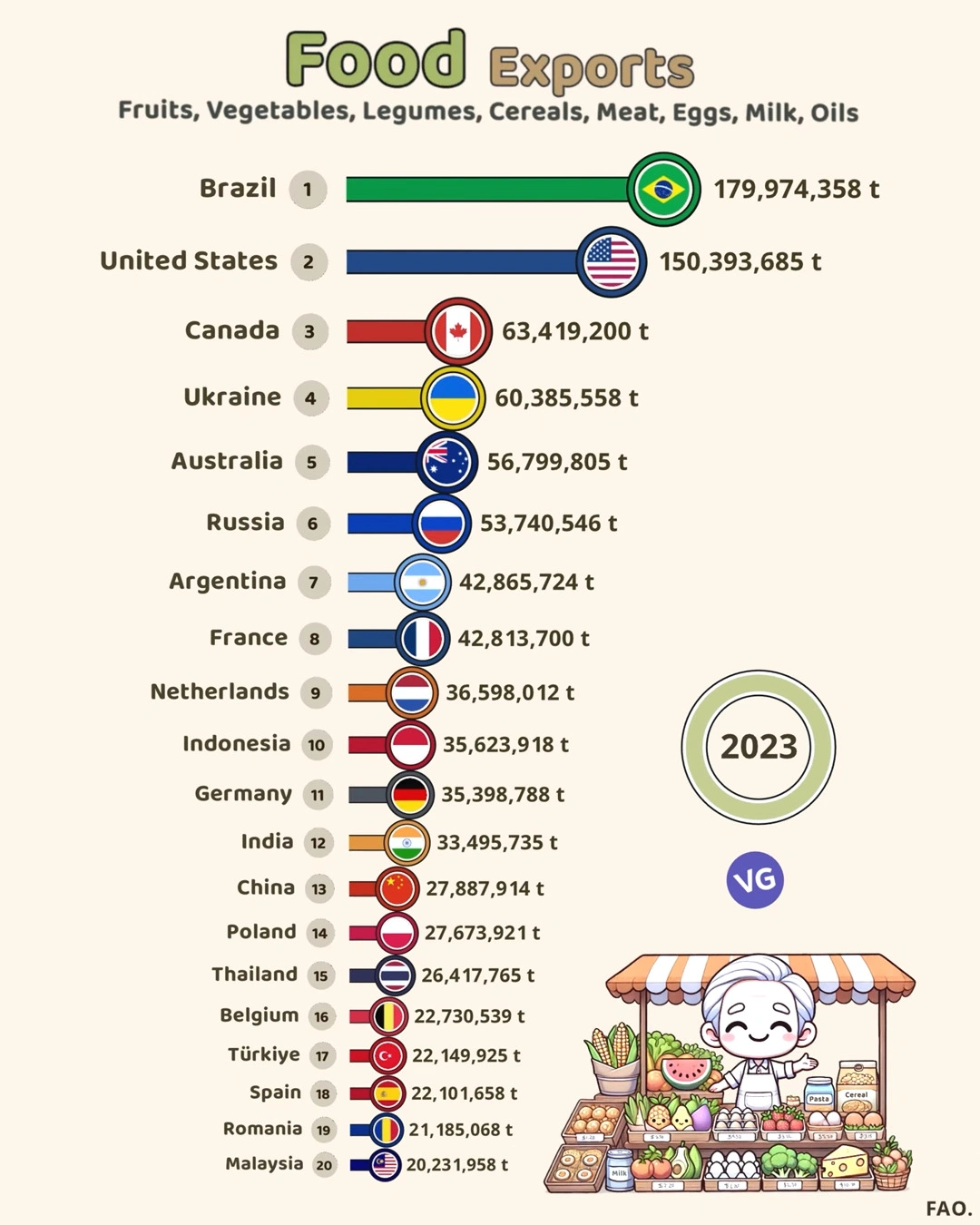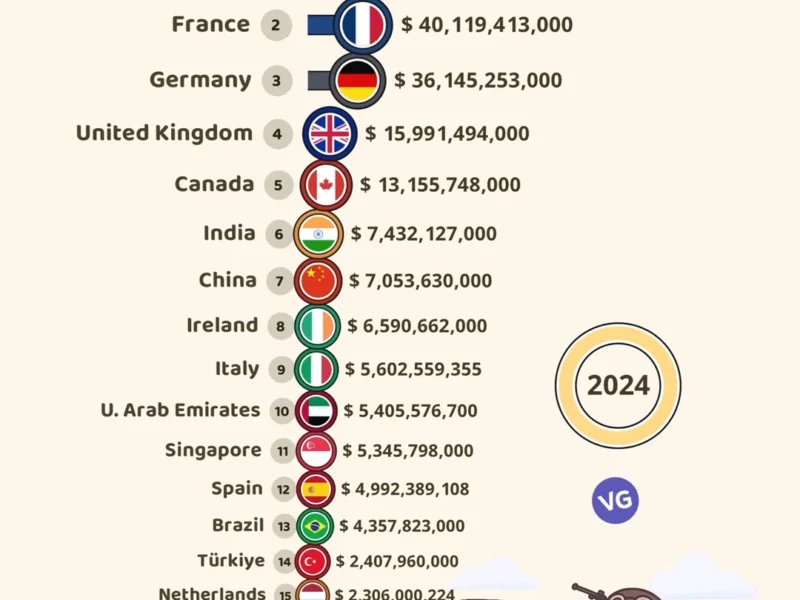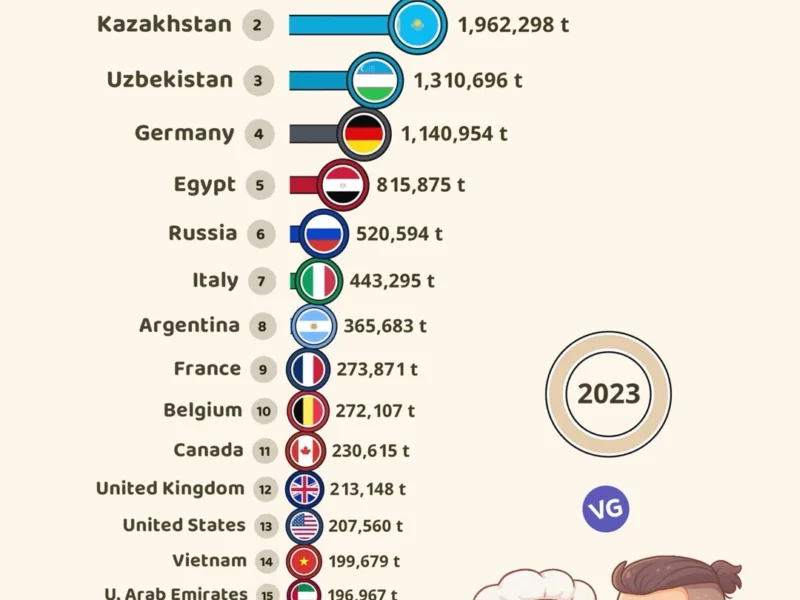The 2023 FAO data on global food exports reveals a complex landscape of agricultural trade, encompassing fruits, vegetables, legumes, cereals, meat, eggs, milk, and oils. This analysis examines the major players and regional patterns in global food trade.
Top Food Exporting Countries (2023)
| Rank | Country & Flag | Food Exports (t) |
|---|---|---|
| 1 | 🇧🇷 Brazil | 179,974,358 t |
| 2 | 🇺🇸 United States | 150,393,685 t |
| 3 | 🇨🇦 Canada | 63,419,200 t |
| 4 | 🇺🇦 Ukraine | 60,385,558 t |
| 5 | 🇦🇺 Australia | 56,799,805 t |
| 6 | 🇷🇺 Russia | 53,740,546 t |
| 7 | 🇦🇷 Argentina | 42,865,724 t |
| 8 | 🇫🇷 France | 42,813,700 t |
| 9 | 🇳🇱 Netherlands | 36,598,012 t |
| 10 | 🇮🇩 Indonesia | 35,623,918 t |
| 11 | 🇩🇪 Germany | 35,398,788 t |
| 12 | 🇮🇳 India | 33,495,735 t |
| 13 | 🇨🇳 China | 27,887,914 t |
| 14 | 🇵🇱 Poland | 27,673,921 t |
| 15 | 🇹🇭 Thailand | 26,417,765 t |
| 16 | 🇧🇪 Belgium | 22,730,539 t |
| 17 | 🇹🇷 Türkiye | 22,149,925 t |
| 18 | 🇪🇸 Spain | 22,101,658 t |
| 19 | 🇷🇴 Romania | 21,185,068 t |
| 20 | 🇲🇾 Malaysia | 20,231,958 t |
Leading Exporters
Top Tier
- Brazil leads globally with 179,974,358 tonnes
- United States follows with 150,393,685 tonnes
- These two nations together account for a substantial portion of global food exports
Strong Secondary Players
- Canada: 63,419,200 tonnes
- Ukraine: 60,385,558 tonnes
- Australia: 56,799,805 tonnes
- Russia: 53,740,546 tonnes
European Representation
Europe shows significant presence with multiple countries:
- France: 42,813,700 tonnes
- Netherlands: 36,598,012 tonnes
- Germany: 35,398,788 tonnes
- Poland: 27,673,921 tonnes
- Belgium: 22,730,539 tonnes
- Spain: 22,101,658 tonnes
- Romania: 21,185,068 tonnes
Asian-Pacific Contributors
The Asia-Pacific region demonstrates varied export volumes:
- Indonesia: 35,623,918 tonnes
- India: 33,495,735 tonnes
- China: 27,887,914 tonnes
- Thailand: 26,417,765 tonnes
- Malaysia: 20,231,958 tonnes
Key Observations
Regional Distribution
- Americas dominate the top positions
- Strong European representation in mid-range volumes
- Significant Asian presence across various positions
- Australia’s strong position as a major exporter
Economic Implications
- Food security contributions
- Trade balance impacts
- Agricultural sector development
- International market relationships
- Economic diversification opportunities
Future Considerations
The data suggests several important trends:
- Continued dominance of traditional agricultural powerhouses
- Growing importance of emerging market exporters
- Diverse product mix across different regions
- Significance of agricultural trade in global food security
This comprehensive view of global food exports demonstrates the complex interconnections in global food trade and the varied roles different nations play in feeding the world’s population.



